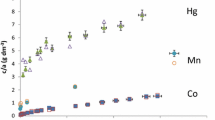Abstract
Experimental cation exchange capacities (CEC) of kaolinites were determined and compared to theoretical calculations of CEC. The comparison reveals that the exchangeable cations occur mostly on the edges and on the basal (OH) surfaces of the mineral. It also shows that permanent negative charge from isomorphous substitution of Al3+ for Si4+ is insignificant. The CEC of kaolinite strongly depends on the particle size (both thickness and diameter in the (00l plane) and pH value. Particle size is more important than crystallinity in affecting kaolinite CEC. This study shows that the hydroxyls on the exposed basal surfaces may be ionizable in aqueous solutions. The amount of negative charge on the edges and the exposed basal hydroxyls depends on pH and other ion concentrations. A higher pH value gives rise to more negative charges, which lead to a higher CEC value. This study indicates that charge from broken edges and exposed OH planes rather than charge from Al/Si substitution determines the kaolinite CEC, even at zero point charge. A high CEC in some kaolinites is found to be due to smectite layers on the surface of the kaolinite crystals.
Similar content being viewed by others
References
Bailey, S.W. (1984) Structures of layer silicates. In Crystal Structures of Clay Minerals and Their X-ray Identification, G.W. Brindley and G. Brown, eds., Mineralogical Society, London, 1–124.
Bain, D.C. and Smith, B.F.L. (1987) Chemical analysis. In A Handbook of Determinative Methods in Clay Mineralogy, M.J. Wilson, ed., Blackie, Glasgow, 301–320.
Bolland, M.D.A., Posner, A.M., and Quirk, J.P. (1976) Surface charge on kaolinites in aqueous suspension. Australian Journal of Soil Research, 14, 197–216.
Brown, G. and Brindley, G.W. (1984) X-ray diffraction procedure for clay mineral identification. In Crystal Structures of Clay Minerals and Their X-ray Identification, G.W. Brindley and G. Brown, eds., Mineralogical Society, London, 305–360.
Churchman, G.W., Slade, P.G., Self, P.G., and Janik, L.J. (1994) Nature of interstratified kaolin-smectites in some Australian soils. Australian Journal of Soil Research, 32, 805–822.
Ferris, A.P. and Jepson, W.B. (1975) The exchange capacities of kaolinite and the preparation of homoionic clays. Journal of Colloid Interface Science, 51, 245–259.
Grim, R.E. (1968) Clay Mineralogy. McGraw-Hill, New York, 596 pp.
Kim, Y., Kirkpatrick, R.J., and Cygan, R.T. (1996) Cs-133 NMR study of cesium of the surfaces of kaolinite and illite. Geochimica et Cosmochimica Acta, 60, 4059–4074.
Ma, C. (1996) The ultra-structure of kaolin. Ph.D. thesis, Australian National University, Canberra, Australia, 343 pp.
McBride, M.B. (1976) Origin and position of exchange sites in kaolinite: As ESR study. Clays and Clay Minerals, 24, 88–92.
McBride, M.B. (1989) Surface chemistry of soil minerals. In Minerals in Soil Environments (2nd edition), J.B. Dixon and S.B. Weed, eds., Soil Science Society of America, Madison, Wisconsin, 35–88.
Rand, B. and Melton, I.E. (1977) Particle interactions in aqueous kaolinite suspensions, I. Effect of pH and electrolyte upon the mode of particle interaction in homoionic sodium kaolinite suspensions. Journal of Colloid Interface Science, 60, 308–320.
Schindler, P.W. and Stumm, W. (1987) The surface chemistry of oxides, hydroxides, and oxide minerals. In Aquatic Surface Chemistry, W. Stumm, ed., Wiley Interscience, New York, 83–110.
Schofield, R.K. and Samson, H.R. (1953) The deflocculation of kaolinite suspensions and the accompanying change over from positive to negative chloride adsorption. Clay Minerals Bulletin, 2, 45–51.
Sposito, G. (1984) The Surface Chemistry of Soils. Oxford University Press, New York, 227 pp.
van Olphen, H. (1977) Clay Colloid Chemistry, 2nd edition. John Wiley & Sons, New York, 318 pp.
Wieland, E. and Stumm, W. (1992) Dissolution kinetics of kaolinite in acidic aqueous solution at 25°C. Geochimica et Cosmochimica Acta, 56, 3339–3355.
Williams, D.J.A. and Williams, K.P. (1978) Electrophoresis and zeta potential of kaolinite. Journal of Colloid Interface Science, 65, 79–87.
Zhou, Z. and Gunter, W.D. (1992) The nature of the surface charge of kaolinite. Clays and Clay Minerals, 40, 365–368.
Author information
Authors and Affiliations
Rights and permissions
About this article
Cite this article
Ma, C., Eggleton, R.A. Cation Exchange Capacity of Kaolinite. Clays Clay Miner. 47, 174–180 (1999). https://doi.org/10.1346/CCMN.1999.0470207
Received:
Accepted:
Published:
Issue Date:
DOI: https://doi.org/10.1346/CCMN.1999.0470207



